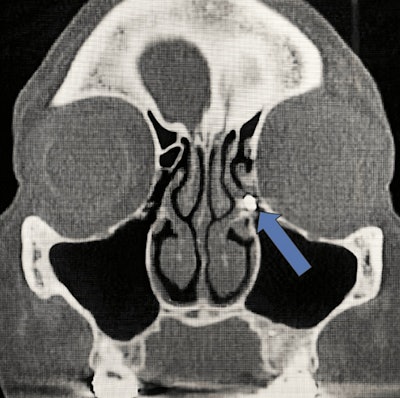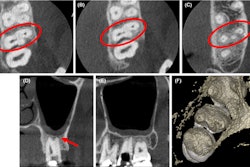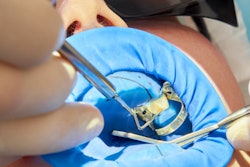A 49-year-old woman in Nevada developed foreign body (FB) sinusitis after amalgam restorative material moved from a tooth in her upper jaw into the paranasal sinuses. The case report was published recently in Cureus Journal of Medical Science.
This case was especially remarkable considering the woman's occupation as a flight attendant. The woman, who made a full recovery after surgical removal of the metal dental material, was exposed to pressure changes followed by barotrauma, tissue damage caused by unrelieved pressure in a body cavity like the sinuses due to her regular air travel, according to the report.
"These previously stated factors may accelerate FB migration within the sinuses," wrote the authors, led by Dr. Scott Manthei of the Nevada Ear and Sinus Institute in Las Vegas (Cureus, March 6, 2024).
Woman with midface pain, pressure
After experiencing pressure in the face, which was exacerbated when flying, for about two months, a 49-year-old woman visited a physician. She reported feeling localized pain and pressure in the midface that she attributed to a metal FB in her sinuses. The FB was incidentally detected on dental imaging she previously underwent, according to the report.
The woman's medical history included no sinusitis, head trauma, or nasal surgeries, but she had previous bilateral retinal surgeries and extensive dental treatment.
A comprehensive otorhinolaryngological exam revealed hypertrophic turbinates and a mild septal deviation, and a computed tomography (CT) scan of the paranasal sinuses confirmed a 3-mm radiopaque FB near the left maxillary infundibulum, with minimal left ethmoid sinus mucosal thickening. Despite the findings, she chose nonoperative management of the problem, the authors wrote.
 Metal foreign body in the ethmoid infundibulum. Image courtesy of Kramer et al. Licensed under CC BY 4.0.
Metal foreign body in the ethmoid infundibulum. Image courtesy of Kramer et al. Licensed under CC BY 4.0.
Over the next year, the woman had recurring severe facial swelling and congestion that antibiotics helped but never resolved.
Another CT scan of the sinuses appeared to show what was most likely amalgam that moved from her maxilla to the ethmoid infundibulum, where it became stuck between the uncinate process and ethmoid bulla. Furthermore, the foreign body seemed to have eroded into the bulla and ethmoid air cell mucosal thickening.
Due to her previous eye surgeries, the woman was worried about the object's continued migration toward the orbit. This, along with the chronic pain she experienced, resulted in the woman undergoing endoscopic sinus surgery. Doctors took down her uncinate process and ethmoid bulla and removed the calcified mass from the infundibulum between the maxillary and ethmoid sinus, they wrote.
More to learn
With the increased use of dental implants, FB migration into the maxillary sinus is becoming more prevalent. However, sinusitis caused by a FB is rare. About 60% of paranasal sinus FBs are due to intrinsic or complications from medical treatment. In those cases that have iatrogenic roots, dental procedures are the leading cause, the authors wrote.
Since this case report offers an unusual picture of foreign body mucosal injury compounded by job-related barotrauma, clinicians should consider a patient's occupational background when making clinical decisions for patients diagnosed with sinusitis caused by a foreign object.
"Furthermore, interdisciplinary history, particularly in dentistry, is essential in investigating the etiology of sinonasal FBs," Manthei and colleagues wrote.




















